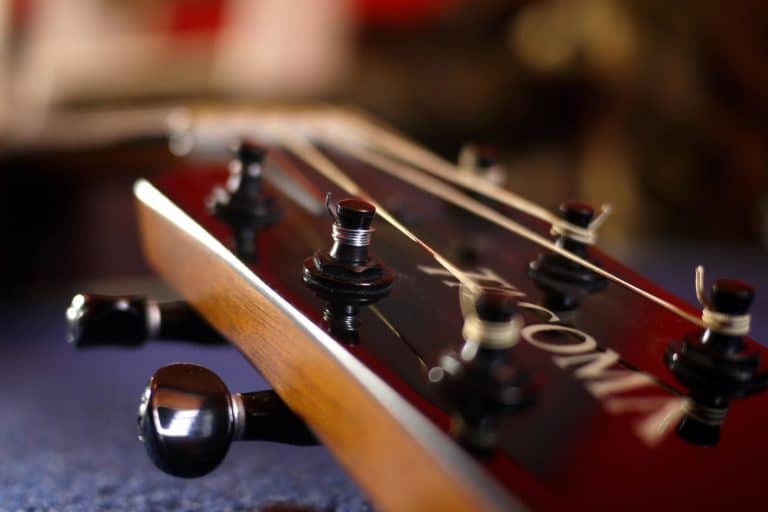Guitar River is reader-supported. We may earn a commission when you make a purchase using the links on our site.
Learn more.
How to Keep Your Electric Guitar In Tune, and Which Ones Stay In Tune The Best

One thing all guitarists struggle with at some point is keeping their guitar in tune. Nothing is more frustrating than constantly needing to tune your guitar. There are a few tricks you can use to help keep your guitar in tune, and some options you should consider as upgrades or when shopping for a guitar.
No one particular electric guitar stays in tune the best. Any guitar that is set up properly will hold its tune. However, guitars with certain characteristics such as locking tuners, a high-quality guitar nut, a fixed bridge, or a locking tremolo system will hold their tune better. We will go over the steps below to set up your guitar correctly the next time you change the guitar strings.
If you are looking for suggestions on which electric guitars stay in tune better than others, see below for our guitar recommendations. We also include links to our setup tools. Now, on to the guitar setup process.
Tighten The Tuning Pegs
When your strings are off the guitar, check if your tuning machines are loose. Over time, the tuning pegs can get loose, and this will contribute to tuning issues. You can easily tighten them with the correct size socket wrench. I like to use the MusicNomad GRIP Winder. On the end of the handle, there is a 10mm hex wrench you can use to tighten the tuning pegs. It’s a rubberized material so you’re not going to scratch up your guitar with it.
Lubricate The Guitar Nut
Another key practice to help keep your guitar in tune is to lubricate the guitar nut. The guitar nut is the small piece of material where the strings exit the fretboard and go to the tuning pegs. It is usually made out of plastic, bone, or a graphite material.
You can buy guitar nut lubricant at a music store or online. Another low-tech and inexpensive solution is to use a mechanical pencil. Apply the graphite from the pencil to the nut slots to add some lubrication for the guitar strings.
Lubricate Moving Parts and Pivot Points
You can apply the same lubricant to other moving parts of the guitar, and where the strings pass over or through different metal parts. For example, lubricate the individual bridge saddles, the string trees, and the pivot points of your tremolo system.
Some like to use gun oil or another similar oil on the metal parts. The same lubricant you use for the nut will work fine. The MusicNomad TUNE-IT lubricant can be used for the nut, bridge saddles, string trees, and other moving parts.
Seat The Guitar Strings
This is an easily overlooked item. Make sure the ball-ends of the guitar string are seated properly. If you are feeding the strings through a tremolo block, the ball-ends can get stuck on the outside edge of the tremolo block if you’re not careful. Double check and make sure the strings are seated properly before you tune to pitch.
Lock The Guitar Strings
When changing the strings, it is important to lock the new strings to the tuning pegs. This will go a long way in reducing tuning problems. You lock the strings by bending the string back and over itself. As you tighten the string, the string will lock into place.
This reduces the amount of string movement around the tuning pegs. By locking the strings, it also reduces the number of string winds around the peg. That is key as the more guitar string you have around the tuning pegs, there is more opportunity for string movement.
You can measure the amount of string to use by pulling up on the guitar string, and leaving about a fingers length of space between the string and the fretboard. This rough measurement will help you from winding too much guitar string around the tuning pegs.
Note that if you plan to use a drop-tuning, leave some extra string for that purpose.
The following video explains the procedure of locking the strings.
Stretch The Guitar Strings
After you lock the string and tune it to pitch, you need to gently stretch the string. Pull it upwards away from the guitar until it is taught. Repeat this a few times. The string will go out of tune and it will be flat. Tune it back to pitch, and repeat the process until the string holds its pitch. Note that it is better to tune up to pitch to keep tension on the string, instead of tuning down to pitch.
Locking Tuners
Locking tuners are a nice upgrade that can help keep your guitar in tune. Using locking tuners, you lock the string in place and then tighten the string. This is a more sure fire way of keeping the strings locked than the method described above.
You can upgrade to locking tuners for about $80-100. There are locking tuning machines available such as the Hipshot Locking Tuners that will mount to your guitar without the need to drill any new holes. The Hipshot system includes a mounting plate and the tuners are easily added without drilling.
Fixed Bridge or Tremolo
Something else that will impact your guitar’s tuning stability is whether you have a fixed bridge or a tremolo system. Tremolos can be more difficult to set up, and can sometimes contribute to tuning issues. But a properly set up tremolo can be just as stable as a fixed bridge.
If you are just starting out and shopping for a guitar, you might want to consider a guitar with a fixed bridge to avoid any issues with the tremolo. You likely won’t be using the tremolo to begin with in any case.
If you have a tremolo, make sure you lubricate any pivot points as described above. You can also block it by using a piece of wood to restrict movement and tightening the tremolo springs in the cavity on the back of the guitar. This will keep the tremolo flat, and it will act the same as a fixed bridge.
Floyd Rose Tremolo
The Floyd Rose tremolo system deserves its own category. When set up properly, this can be a very stable system, and the guitar will stay in tune with only minor adjustments of the fine tuners needed. However, these tremolos are notoriously difficult to set up for beginners. And if you break a string, everything goes out of tune and you are stuck until you change the string.
The reason a guitar with a Floyd Rose will hold its tune if set up properly is due to the double locking mechanism. The strings are locked at the guitar nut as well as at the bridge. For guitars with a tremolo system, a guitar with a Floyd Rose tremolo will arguably hold its tune better than those with a non-locking system.
Changes In Temperature and Humidity
Abrupt changes in temperature and humidity can affect your guitar as well. Keeping your guitar indoors at a consistent temperature will help keep it in tune. If the environment is too dry, you might consider using a case humidifier so the wood does not dry out.
Replace Your Strings Regularly
Over time, your guitar strings will get dirty from the oils on your hands, and they will stretch out. The strings will lose that bright tone you hear with new strings. They will sound flat and won’t intonate as well. Keeping the guitar strings relatively new will help keep your guitar in tune.
Guitar Recommendations
Here are a few suggestions for guitars that may stay in tune a little better on average, as long as they are properly set up. Most of these guitars are in the mid-price range of $500-1,000. Three on our list under $1,000 have locking tuners.
If you are looking to spend more, you can expect upgrades such as locking tuners, better hardware and electronics, and top of the line finishing details.
Fender Player Series Telecaster
With a string-through-body fixed-bridge, synthetic bone nut, and standard tuners, the Player Series Telecaster gives you an excellent playing platform and solid tuning stability without breaking the bank.
Epiphone Les Paul Standard
The LP Standard has a Tune-o-matic bridge, stopbar tailpiece, deluxe tuning machines, and a Graph Tech nut all contributing to tuning stability.
PRS SE Standard 245
The PRS SE Standard 245 gives you classic single-cut looks and PRS playability, with a wrap-around tailpiece and PRS-designed tuners to keep it all in tune.
Yamaha Pacifica 612
The Yamaha Pacifica series guitars are an excellent value. The 612 line gives you locking tuners by Grover, a Wilkinson bridge, and a Graph Tech Tusq nut. It’s a versatile and playable guitar, and the upgraded hardware ensure tuning stability at a very fair price.
Jackson X Series Soloist
The Jackson Soloist keeps the shredders happy with a compound-radius fretboard, and a Floyd Rose double-locking tremolo to keep things in tune.
Fender Player Series Strat with Floyd Rose
If you love Strats, but don’t enjoy the tremolo system, you might consider the Player Series Floyd Rose version. It has all that you love about Strats, and reduces tuning issues with the double-locking Floyd Rose tremolo system.
ESP LTD EC-1000
The ESP LTD EC-1000 is a great value and a versatile and fast-playing guitar. To keep you in tune, the EC-1000 sports a TonePros bridge and locking tuners right from the start.
Schecter Solo II Custom
For just under $1,000, consider the Schecter Solo II Custom. It has locking tuners, an Ernie Ball compensated nut, and a Tune-o-matic bridge to hold it in tune. Plus, it’s a fantastic and versatile guitar, and an excellent value.
If you are able to spend more than $1,000, we suggest the following.
Fender American Professional Stratocaster
It’s the Strat you know and love, but with top-notch hardware, a bone nut, and stunning good looks. It’s not inexpensive, but still within reason. If you want locking tuners, hold on to your wallet and check out the American Ultra Stratocaster.
Ernie Ball Music Man Cutlass SSS
With Schaller locking tuners, an Ernie Ball compensated nut, and a custom bridge, the Cutlass is a phenomenal guitar, and will hold its tune thanks to these appointments.
Shop for electric guitars at Reverb.
Recommendations
- If you are just starting out and shopping for a guitar that stays in tune, we recommend a guitar with a fixed bridge instead of a tremolo.
- During the setup process, tighten the tuning pegs when the strings are off the guitar.
- Lubricate the guitar nut with a specialized lubricant or a mechanical pencil.
- Lubricate other pivot points such as the tremolo pivots and the bridge saddles.
- Lubricate any part that touches the strings such as the string trees.
- Make sure you lock your guitar strings to the tuning pegs when changing strings.
- Stretch the strings until they stay in tune and tune up to pitch.
- Consider a guitar with locking tuners, or purchase a set for a relatively low cost upgrade.
- Weigh whether you want a fixed bridge or a tremolo system.
- If you have a tremolo system, you could consider blocking it.
- If you are an intermediate or advanced player, consider a guitar with a Floyd Rose tremolo system.
- Keep your guitar at a consistent temperature and humidity.
- Change your strings regularly.



